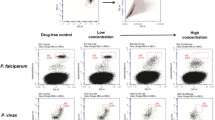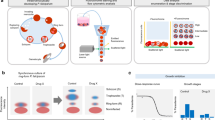Abstract
The in vivo efficacy of potential antimalarials is usually evaluated by direct microscopic determination of the parasitaemia of Plasmodium-infected mice on Giemsa-stained blood smears. This process is time-consuming, requires experienced technicians and is not automatable. Therefore, we optimized a SYBR Green I (SYBRG I) fluorescence-based assay to fluorometers commonly available in many research laboratories. This technique was originally developed to assess parasitaemia in humans by cytometry. We defined optimal conditions with Plasmodium berghei-infected mice, standard lysis buffer (Tris, EDTA, saponin and Triton), whole blood cells and 2 h staining incubation with SYBRG I 2X. The fluorescence background generated by uninfected whole blood cells was low (around 4.6%), and the linearity high (r 2 = 0.96), with parasitaemia ranging from 1.4 to 60%. The Bland–Altman plot showed a strong correlation between SYBRG I and Giemsa gold standard method; Z′-factor was >0.5. These findings suggest that our fluorescence-based assay is suitable for in vivo antimalarial drug assessment in a malaria murine model. It can help to overcome the human bias found with microscopic techniques.





Similar content being viewed by others
References
Akala HM, Eyase FL, Cheruiyot AC et al (2011) Antimalarial drug sensitivity profile of western Kenya Plasmodium falciparum field isolates determined by a SYBR Green I in vitro assay and molecular analysis. AmJTrop Med Hyg 85:34–41
Arias MH, Rodríguez YV, Garavito G (2016) Adaptation and optimization of a fluorometric reading method, in the in vitro pharmacological model of Plasmodium falciparum culture. Rev Colomb Cienc Quím Farm 45(1):127–146
Bacon DJ, Latour C, Lucas C et al (2007) Comparison of a SYBR green I-based assay with a histidine-rich protein II enzyme-linked immunosorbent assay for in vitro antimalarial drug efficacy testing and application to clinical isolates. Antimicrob Agents Chemother 51:1172–1178
Benelli G, Mehlhorn H (2016) Declining malaria, rising of dengue and Zika virus: insights for mosquito vector control. Parasitol Res 115:1747–1754
Bland JM, Altman DG (1986) Statistical methods for assessing agreement between two methods of clinical measurement. Lancet 1:307–310
Bland JM, Altman DG (1999) Measuring agreement in method comparison studies. Stat Methods Med Res 8:135–160
Chaorattanakawee S, Tyner SD, Lon C et al (2013) Direct comparison of the histidine-rich protein-2 enzyme-linked immunosorbent assay (HRP-2 ELISA) and malaria SYBR green I fluorescence (MSF) drug sensitivity tests in Plasmodium falciparum reference clones and fresh ex vivo field isolates from Cambodia. Malar J 12;12:239
Cheruiyot AC, Auschwitz JM, Lee PJ et al (2016) Assessment of the worldwide antimalarial resistance network standardized procedure for in vitro malaria drug sensitivity test using SYBR green assay for field samples with varying initial parasitemia. Antimicrob Agents Chemother. doi:10.1128/AAC.00527-15
Chevalley S, Coste A, Lopez A et al (2010) Flow cytometry for the evaluation of anti-plasmodial activity of drugs on Plasmodium falciparum gametocytes. Malar J 9:49
European Medicines Agency (EMEA) (1995) Note for guidance on validation of analytical procedures: text and methodology
Frank-Fayard B, Trueman H, Ramesar J et al (2004) Plasmodium berghei reference line that constitutively expresses GFP at a high level throughout the complete life cycle. Molecular & Biochemical Parasitology 137:23–33
Grimberg BT (2011) Methodology and application of flow cytometry for investigation of human malaria parasites. J Immunol Methods 367:1–16
Guswanto A, Sivakumar T, Rizk MA et al (2014) Evaluation of a fluorescence-based method for antibabesial drug screening. Antimicrob Agents Chemother 58(8):4713–4717
International Conference on Harmonisation (ICH) (1996) Harmonised tripartite guideline: validation of analytical procedures: methodology. Presented at the ICH of Technical Requirements for Registration of Pharmaceuticals for Human Use. The European Agency for the Evaluation of Medicinal Products, London 1–9.
Jensen M, Mehlhorn H (2009) Seventy-five years of Resochin® in the fight against malaria. Parasitol Res 105:609–627
Johnson JD, Dennull RA, Gerena L et al (2007) Assessment and continued validation of the malaria SYBR green I-based fluorescence assay for use in malaria drug screening. Antimicrob Agents Chemother 51:1926–1933
Moneriz C, Marín-García P, Bautista JM et al (2009) Haemoglobin interference and increased sensitivity of fluorimetric assays for quantification of low-parasitaemia Plasmodium infected erythrocytes. Malar J 8:279
Peters W (1975) The chemotherapy of rodent malaria, XXII. The value of drug resistant strains of P. berghei in screening for blood schizontocidal activity. Ann Trop Med Parasitol 69:155–171
Peters W and Robinson BL (1999) Malaria. In: Zak O (ed) Handbook of animal models of infection. New York, pp 757–773
Rason MA, Randriantsoa T, Andrianantenaina H et al (2008) Performance and reliability of the SYBR Green I based assay for the routine monitoring of susceptibility of Plasmodium falciparum clinical isolates. Trans R Soc Trop Med Hyg 102:346–351
Siu E, Ploss A (2015) Modeling malaria in humanized mice: opportunities and challenges. Ann N Y Acad Sci 1342:29–36
Smeijsters LJ, Zijlstra NM, Franssen FF, Overdulve JP (1996) Simple, fast, and accurate fluorometric method to determine drug susceptibility of Plasmodium falciparum in 24-well suspension cultures. Antimicrob Agents Chemother 40:835–838
Smilkstein M, Sriwilaijaroen N, Kelly JX et al (2004) Simple and inexpensive fluorescence-based technique for high-throughput antimalarial drug screening. Antimicrob Agents Chemother 48(5):1803–1806
Somsak V, Srichairatanakool S, Yuthavong Y et al (2012) Flow cytometric enumeration of Plasmodium berghei-infected red blood cells stained with SYBR Green I. Acta Trop 122:113–118
Tu Y (2011) The discovery of artemisinin (qinghaosu) and gifts from Chinese medicine. Nature Med 17(10):1217–1220
Vossen MG, Pferschy S, Chiba P, Noedl H (2010) The SYBR Green I malaria drug sensitivity assay: performance in low parasitemia samples. AmJTrop Med Hyg 82:398–401
Zhang JH, Chung TDY, Oldenburg KR (1999) A simple statistical parameter for use in evaluation and validation of high throughput screening assays. J Biomol Screen 4:67–73
Acknowledgements
We are grateful to Elizabeth Elliott for valuable editorial assistance. This study was funded by the Departamento Administrativo de Ciencia, Tecnología e Innovación (Colciencias) and the French Ministère des Affaires étrangères et du Développement international (MAEE) through ECOSNORD 2013 program [HERMES-28693] and the Vicedecanatura de Investigación, Facultad de Ciencias, Universidad Nacional de Colombia.
Author information
Authors and Affiliations
Corresponding author
Ethics declarations
Conflict of interest
The authors declare that they have no conflict of interest.
Rights and permissions
About this article
Cite this article
Arias, M.H., Deharo, E., Valentin, A. et al. Adaptation and optimization of a fluorescence-based assay for in vivo antimalarial drug screening. Parasitol Res 116, 1955–1962 (2017). https://doi.org/10.1007/s00436-017-5477-z
Received:
Accepted:
Published:
Issue Date:
DOI: https://doi.org/10.1007/s00436-017-5477-z




